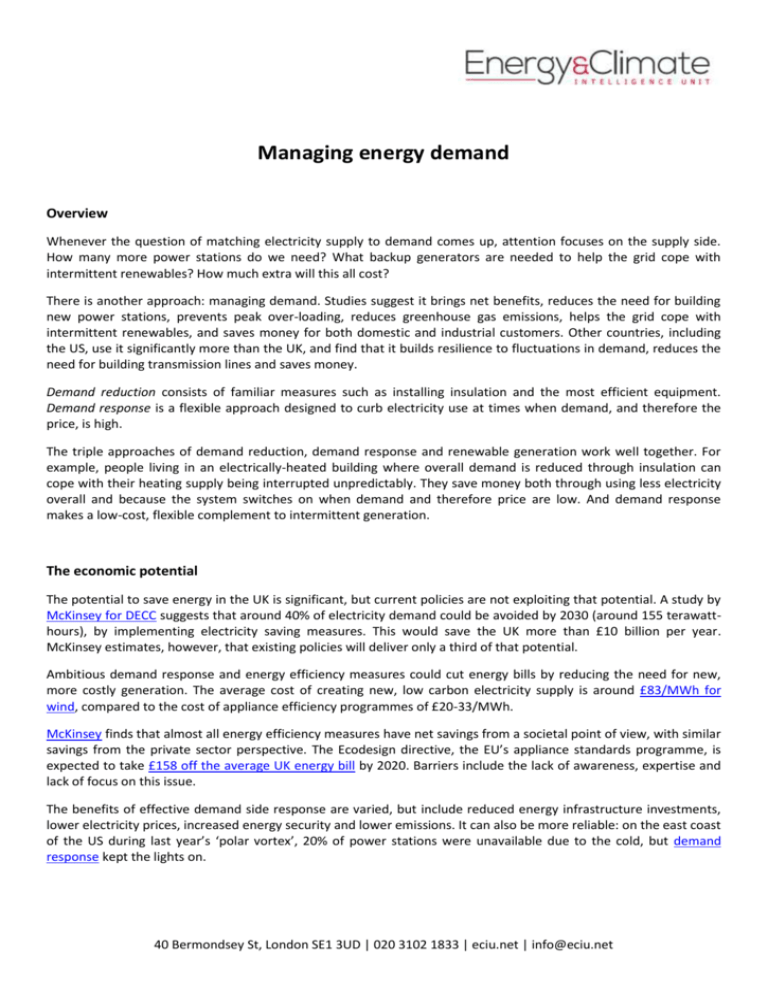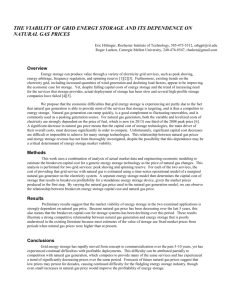backgrounder
advertisement

Managing energy demand Overview Whenever the question of matching electricity supply to demand comes up, attention focuses on the supply side. How many more power stations do we need? What backup generators are needed to help the grid cope with intermittent renewables? How much extra will this all cost? There is another approach: managing demand. Studies suggest it brings net benefits, reduces the need for building new power stations, prevents peak over-loading, reduces greenhouse gas emissions, helps the grid cope with intermittent renewables, and saves money for both domestic and industrial customers. Other countries, including the US, use it significantly more than the UK, and find that it builds resilience to fluctuations in demand, reduces the need for building transmission lines and saves money. Demand reduction consists of familiar measures such as installing insulation and the most efficient equipment. Demand response is a flexible approach designed to curb electricity use at times when demand, and therefore the price, is high. The triple approaches of demand reduction, demand response and renewable generation work well together. For example, people living in an electrically-heated building where overall demand is reduced through insulation can cope with their heating supply being interrupted unpredictably. They save money both through using less electricity overall and because the system switches on when demand and therefore price are low. And demand response makes a low-cost, flexible complement to intermittent generation. The economic potential The potential to save energy in the UK is significant, but current policies are not exploiting that potential. A study by McKinsey for DECC suggests that around 40% of electricity demand could be avoided by 2030 (around 155 terawatthours), by implementing electricity saving measures. This would save the UK more than £10 billion per year. McKinsey estimates, however, that existing policies will deliver only a third of that potential. Ambitious demand response and energy efficiency measures could cut energy bills by reducing the need for new, more costly generation. The average cost of creating new, low carbon electricity supply is around £83/MWh for wind, compared to the cost of appliance efficiency programmes of £20-33/MWh. McKinsey finds that almost all energy efficiency measures have net savings from a societal point of view, with similar savings from the private sector perspective. The Ecodesign directive, the EU’s appliance standards programme, is expected to take £158 off the average UK energy bill by 2020. Barriers include the lack of awareness, expertise and lack of focus on this issue. The benefits of effective demand side response are varied, but include reduced energy infrastructure investments, lower electricity prices, increased energy security and lower emissions. It can also be more reliable: on the east coast of the US during last year’s ‘polar vortex’, 20% of power stations were unavailable due to the cold, but demand response kept the lights on. 40 Bermondsey St, London SE1 3UD | 020 3102 1833 | eciu.net | info@eciu.net Demand response and the Capacity Mechanism The National Grid already uses demand response to balance the grid, and to deal with sudden unexpected outages such as the weekend’s fire at Didcot B. Whereas some of this involves keeping power stations in spinning reserve, able to contribute power at very short notice, the other side consists of reducing demand. Typically contracts are made with industrial customers, allowing the grid to switch off non-essential equipment remotely. Recently the grid expanded its raft of demand-side measures by introducing the Demand Side Balancing Reserve. In return for a fee, industrial customers agree that the Grid can turn off supplies during weekday evenings, 4-8pm – the time of peak demand. The UK Capacity Mechanism, the process designed to ensure there is sufficient generating capacity and manage increasing intermittency from 2018 onwards, is about to hold its first auction. Providers of demand response are allowed to bid in, but on a very unequal footing compared with generators. They can only bid for one-year contracts whereas generators can bid for one, three or 15-year contracts. The total capacity being auctioned to demand-side providers is 0.7 gigawatts (GW) from a total in the market of 50.8GW. The Energy and Climate Change Select Committee says this ‘design flaw’ could ‘lead to the construction of expensive new power stations that are not actually required’. This will ‘lock in unnecessary high-carbon generation capacity instead of innovative demand-side solutions, leading to higher bills and increased greenhouse gas emissions’. Consultancy NERA calculates that changing the rules to incentivise demand management providers could save £359 million per year. Emerging technology: Innovation and Smart Grids Now, a new raft of demand response solutions is emerging. This ‘smart grid’ approach allows suppliers to monitor demand (and therefore price) to customers almost in real time, and turn off non-essential equipment at times of high demand, saving money. An Ernst and Young report for SmartGridGB stated that the development of smart grids could deliver economic benefits amounting to approximately £13bn of Gross Value Added between now and 2050; boosting export earning by £5 billion, and creating 9,000 jobs during the 2030s. These benefits arise from a reduced need to install new power lines and substations, the ability to manage new flows of electricity from household renewables, heat pumps, and electric cars, and more sophisticated demand response. Automated demand reduction systems would mean that signals can be sent to electricity-using devices to be turned off at times of high-demand and high-price. For example, in California, Honeywell has installed systems for water utilities companies to help them avoid energy costs. At household level, the Nest thermostat, which automatically adjusts home heating depending on what time you get home and what the weather is like, shows how smart meters could help reduce consumption at peak times – for example, by temporarily shutting down refrigerators for a short period. Case studies Texas Standard offer Programme: Saving over $300 million per year Since 1999, there has been a package of programmes to save electricity and reduce the peak electricity load in Texas. The package includes a ‘standard offer’ similar to a Feed-In Tariff. Under this scheme, incentive payments range from $100-200 per kW reduction. The programmes are currently saving electricity consumers over $300 million per year, according to US regulators. Germany: Smoothing the Energiewende German industries are beginning to profit from of the country's shift towards variable solar and wind energy, as they enter deals with power firms which let them take more power at times of excess capacity and less when supplies are tight. Entelios and Denmark's Dong Energy are among the companies helping manufacturers to earn rebates on their power bills. North America: Powering through the Polar Vortex During January 2014, the US experienced extreme low temperatures due to the Polar Vortex, with many areas experienced day-time high and overnight-low temperatures that were between 20 degrees and 30 degrees below normal, with 49 cities setting new record lows. During the event, grid operators employed techniques, such as voltage reduction and demand-side management to ensure the bulk electric system reliability was maintained. New England: Savings of $260 million and greater reliability In the US, efficiency resource providers are allowed to participate in capacity markets and compete with the electricity generators. In New England, all energy-saving projects that generate savings at peak time can participate, regardless of payback time or other factors, and there is no restriction on projects being supported by other means. Note that this contrasts with the UK, where there have been restrictions on participation of efficiency projects. Due to this scheme, New England’s system operator (ISO-NE) had sufficient confidence to avoid investing in transmission upgrades, saving $260 million (£156 million). The demand-side resources have also been shown to be more reliable than those on the supply-side. 98% of the demand response resources called on in June 2010 delivered their services, compared with only 49% of online generators. Energy Saving Certificates in New South Wales, Australia In New South Wales, participants in the wholesale electricity market are required to provide evidence on energy efficiency savings. Parties can create energy saving certificates (ESCs) themselves or purchase from others. The scheme costs £20/MWh and has saved the need to purchase energy from power stations costing £70/MWh or more.








